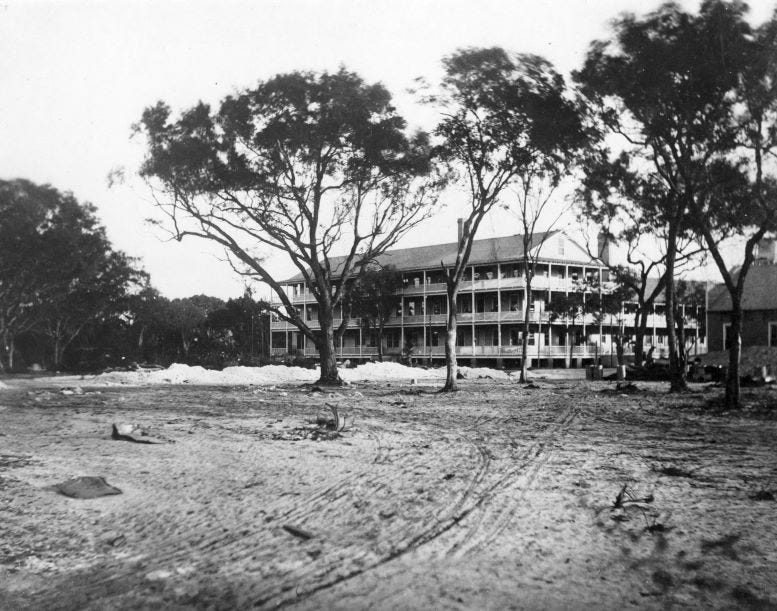Preparing the Grounds for the City of Miami
The preparation for the construction of Henry Flagler's Royal Palm Hotel constructed along the Miami River in today's downtown Miami, Florida, began with arrival of the workforce on March 3, 1896.
In the Fall of 1895, John Sewell was in Palm Beach, Florida, working for Joseph A. McDonald who was the head of the construction arm of the Florida East Coast Railway. It was during a brief meeting that McDonald informed Sewell that he had been selected to go south to begin work on the development of a new city located where Biscayne Bay meets the Miami River. Sewell gladly agreed and expected to get word soon thereafter on when he needed leave for this new venture.
However, Sewell did not hear anything until February of 1896 when McDonald summoned him to meet with Henry Flagler, the principal owner of the Florida East Coast consortium of companies. John would later find out that the delay was due to the complexity of getting title for land that was being given by Julia Tuttle. The claim to the land had at one time been part of Spanish grants and the perfection of the title for this property took more time than everyone expected.
When Sewell arrived in the boss’s office, Flagler informed him that he was ready for Sewell to leave for Biscayne Bay, which was how most people referred to Miami before it was incorporated as the city of Miami. Flagler advised Sewell not to take too many men because he would have trouble housing them. Along with his brother, Everest G. Sewell, John selected twelve of his most trusted black workers to join him for the trip south from West Palm Beach. He referred to this group as his “black artillery”.
Arrived at Biscayne Bay on March 3, 1896
When John Sewell was preparing his crew to depart West Palm Beach for the trip southward, he was greeted by Henry Flagler to wish him well and to provide him a letter of introduction to be given to Julia Tuttle when he arrived. His party consisted of his brother, Everest, and his twelve workers: A.W. Brown, Philip Bowman, Jim Hawkins, Warren Merridy, Richard Mangrom, Romeo Fashaw, Scipio Coleman, Sim Anderson, Dave Heatley, J.B. Brown, William Collier, and Joe Thompson.
The crew departed by train from West Palm Beach to Fort Lauderdale on the morning of March 3, 1896, where they transferred to a steamer named Della to complete the journey by waterway, which was the only option to get to the shores of the Miami River at that time. The men arrived at five o’clock in the evening at the terminus of a street that was carved out of the piney woods along the north bank of the Miami River. This street ran south from the river northward and was given the name of Avenue D, a thoroughfare we know as South Miami Avenue today.
Sewell’s first impression of the area was that it was mostly woods offering little in the way of civilized amenities. It was the beginning of the transformation of dense piney woods into a city. He noticed a steamer that was moored on the Miami River at the base of Avenue D. This vessel arrived earlier in the day and was being setup to offer housing for those arriving by the day looking for work. The steamship was the Rockledge, and it was converted into a floating hotel by Captain Edward Vail.
After disembarking from the Della steamship, John found Julia Tuttle and presented Flagler’s letter as a form of introduction. He visited with Tuttle and her two children for a while and was quite impressed with Julia’s business acumen and with the entire family. They were building Hotel Miami, which was located on the east side of Avenue D near where the crew of fourteen were dropped off.
However, the hotel was still under construction when Sewell and his brother attempted to check-in. As luck would have it, Captain Vail’s Floating Hotel had vacancy and was able to provide lodging for the pair while the Hotel Miami finished preparing a room for John and Everest. Most of the men who arrived prior to Sewell’s crew setup tents or temporary shacks wherever they could find space in the piney woods, which is most likely where Sewell’s workers found accommodations.
The first job that John assigned to his brother Everest was to coordinate his workers to help Harry Tuttle raise the Hotel Miami three feet off the ground using jacks that John had sent a week earlier. This helped Harry Tuttle prepare a room for the brothers. Two days after they arrived, John and Everest were given a room on the second floor of Tuttle’s partially completed inn. The brothers were given a place to stay on the second floor which required them to climb up a ladder to reach a room that did not include an attached door. If one wanted privacy, they needed to lean the unattached door over the space where it would normally close.
Although the hotel was more of a construction zone than a finished product, John commented that it had two windows and was well ventilated. He said in his autobiography, Miami Memoir: “as I was the star boarder, I had more towels than the others, some with real handwork on them and fancy designs.” Sewell was enjoying the celebrity treatment, but it did not provide what many would consider contemporary perks.
Keep reading with a 7-day free trial
Subscribe to Miami History to keep reading this post and get 7 days of free access to the full post archives.






